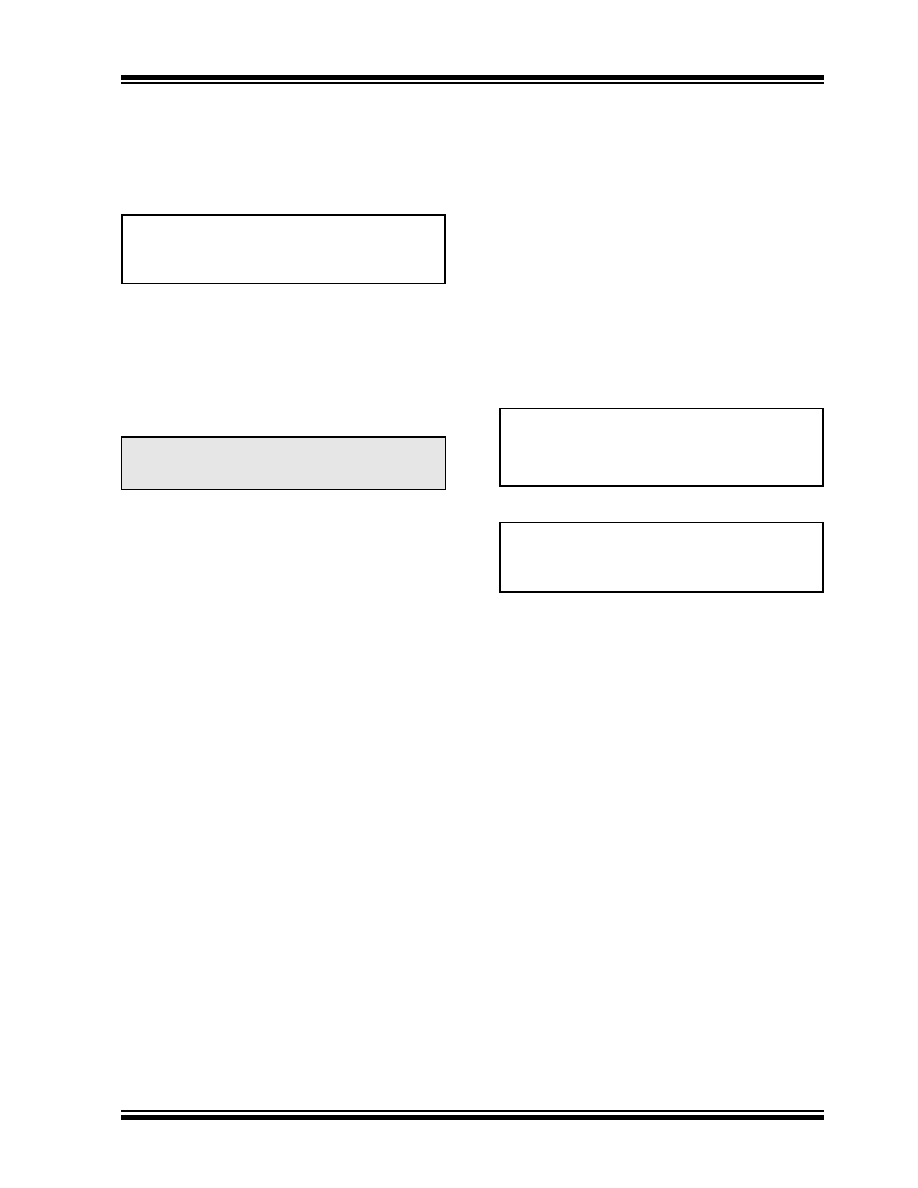- 您現在的位置:買賣IC網 > PDF目錄67987 > MCV18ET-I/SO FLASH, 20 MHz, RISC MICROCONTROLLER, PDSO18 PDF資料下載
參數資料
| 型號: | MCV18ET-I/SO |
| 元件分類: | 微控制器/微處理器 |
| 英文描述: | FLASH, 20 MHz, RISC MICROCONTROLLER, PDSO18 |
| 封裝: | 7.50 MM, LEAD FREE, SOIC-18 |
| 文件頁數: | 62/108頁 |
| 文件大?。?/td> | 1509K |
| 代理商: | MCV18ET-I/SO |
第1頁第2頁第3頁第4頁第5頁第6頁第7頁第8頁第9頁第10頁第11頁第12頁第13頁第14頁第15頁第16頁第17頁第18頁第19頁第20頁第21頁第22頁第23頁第24頁第25頁第26頁第27頁第28頁第29頁第30頁第31頁第32頁第33頁第34頁第35頁第36頁第37頁第38頁第39頁第40頁第41頁第42頁第43頁第44頁第45頁第46頁第47頁第48頁第49頁第50頁第51頁第52頁第53頁第54頁第55頁第56頁第57頁第58頁第59頁第60頁第61頁當前第62頁第63頁第64頁第65頁第66頁第67頁第68頁第69頁第70頁第71頁第72頁第73頁第74頁第75頁第76頁第77頁第78頁第79頁第80頁第81頁第82頁第83頁第84頁第85頁第86頁第87頁第88頁第89頁第90頁第91頁第92頁第93頁第94頁第95頁第96頁第97頁第98頁第99頁第100頁第101頁第102頁第103頁第104頁第105頁第106頁第107頁第108頁

2009 Microchip Technology Inc.
DS41399A-page 57
MCV18E
8.3.1
PWM PERIOD
The PWM period is specified by the PR2 register of
Timer2. The PWM period can be calculated using the
formula of Equation 8-1.
EQUATION 8-1:
PWM PERIOD
When TMR2 is equal to PR2, the following three events
occur on the next increment cycle:
TMR2 is cleared
The CCP1 pin is set. (Exception: If the PWM duty
cycle = 0%, the pin will not be set.)
The PWM duty cycle is latched from CCPR1L into
CCPR1H.
8.3.2
PWM DUTY CYCLE
The PWM duty cycle is specified by writing a 10-bit
value to multiple registers: CCPR1L register and
DC1B<1:0> bits of the CCP1CON register. The
CCPR1L contains the eight MSbs and the DC1B<1:0>
bits of the CCP1CON register contain the two LSbs.
CCPR1L and DC1B<1:0> bits of the CCP1CON
register can be written to at any time. The duty cycle
value is not latched into CCPR1H until after the period
completes (i.e., a match between PR2 and TMR2
registers occurs). While using the PWM, the CCPR1H
register is read-only.
Equation 8-2 is used to calculate the PWM pulse width.
Equation 8-3 is used to calculate the PWM duty cycle
ratio.
EQUATION 8-2:
PULSE WIDTH
EQUATION 8-3:
DUTY CYCLE RATIO
The CCPR1H register and a 2-bit internal latch are
used to double buffer the PWM duty cycle. This double
buffering is essential for glitchless PWM operation.
The 8-bit timer TMR2 register is concatenated with
either the 2-bit internal system clock (FOSC), or 2 bits of
the prescaler, to create the 10-bit time base. The system
clock is used if the Timer2 prescaler is set to 1:1.
When the 10-bit time base matches the CCPR1H and
2-bit latch, then the CCP1 pin is cleared (see
Note:
The Timer2 postscaler (see Section 6.0
“Timer2 Module”) is not used in the
determination of the PWM frequency.
PWM Period
PR2
() 1
+
[] 4TOSC
=
(TMR2 Prescale Value)
Pulse Width
CCPR1L:CCP1CON<5:4>
()
=
TOSC
(TMR2 Prescale Value)
Duty Cycle Ratio
CCPR1L:CCP1CON<5:4>
()
4PR2
1
+
()
-----------------------------------------------------------------------
=
相關PDF資料 |
PDF描述 |
|---|---|
| MCV18E-I/P | 32-BIT, FLASH, 20 MHz, RISC MICROCONTROLLER, PDIP18 |
| MD8086-2/B | 16-BIT, 8 MHz, MICROPROCESSOR, CDIP40 |
| MD80C154-12/883D | 8-BIT, 12 MHz, MICROCONTROLLER, CDIP40 |
| MR83C154TXXX-20/883 | 8-BIT, MROM, 20 MHz, MICROCONTROLLER, CQCC44 |
| MR83C154XXX-20/883D | 8-BIT, MROM, 20 MHz, MICROCONTROLLER, CQCC44 |
相關代理商/技術參數 |
參數描述 |
|---|---|
| MC-V190H | 制造商:Panasonic Industrial Company 功能描述:FILTER KIT |
| M-CV193H | 制造商:Panasonic Industrial Company 功能描述:OD005 |
| MC-V193H | 制造商:Panasonic Industrial Company 功能描述:FILTER KIT |
| MCV19ES | 制造商:Mencom 功能描述: |
| MCV-19FP-FW | 制造商:Mencom 功能描述: |
發(fā)布緊急采購,3分鐘左右您將得到回復。